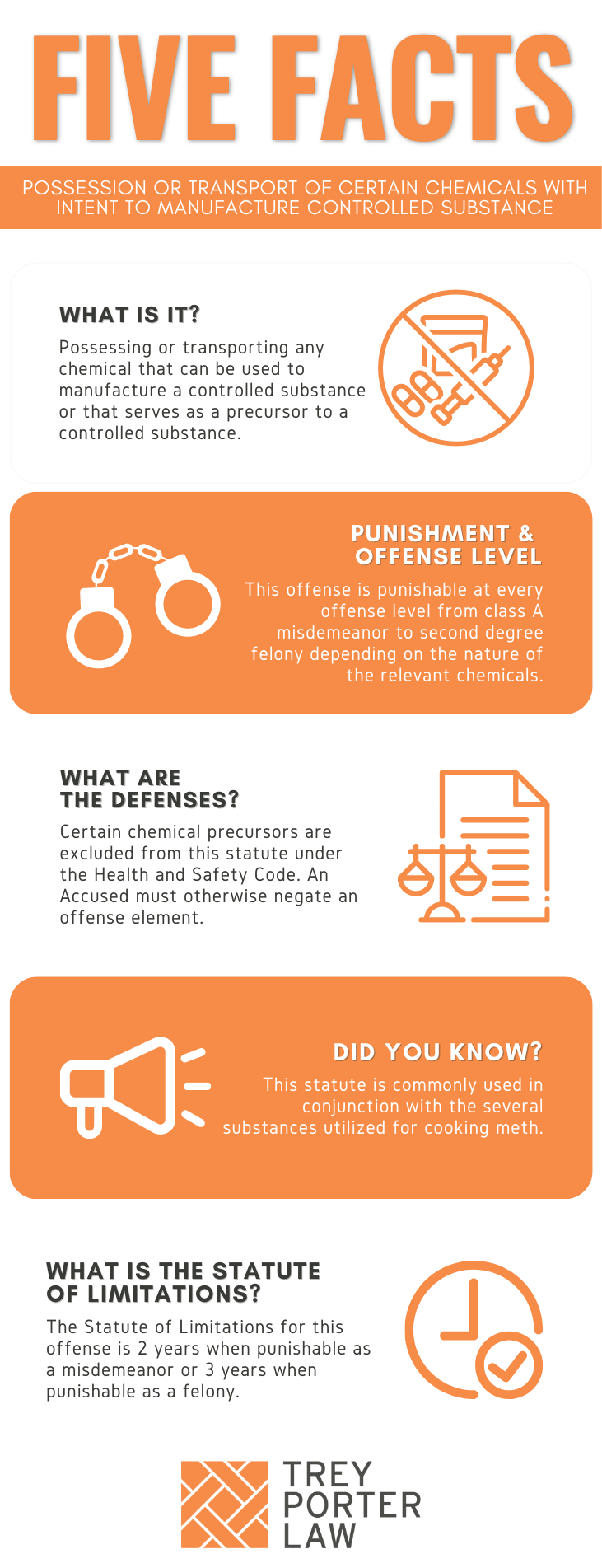WHAT IS POSSESSION OR TRANSPORT OF CERTAIN CHEMICALS WITH INTENT TO MANUFACTURE CONTROLLED SUBSTANCE IN TEXAS?
The Texas law against possession or transport of certain chemicals with intent to manufacture a controlled substance prohibits transporting or otherwise having care, custody, control, or management of a chemical precursor or immediate precursor primarily used in the manufacture of a controlled substance.
- What is a “chemical precursor” in Texas? Texas Health and Safety Code Section 481.002 lists specific chemical precursors:
- Methylamine;
- Ethylamine;
- D-lysergic acid;
- Ergotamine tartrate;
- Diethyl malonate;
- Malonic acid;
- Ethyl malonate;
- Barbituric acid;
- Piperidine;
- N-acetylanthranilic acid;
- Pyrrolidine;
- Phenylacetic acid;
- Anthranilic acid;
- Ephedrine;
- Pseudoephedrine;
- Norpseudoephedrine; or
- Phenylpropanolamine.
- What is an “immediate precursor” in Texas? Texas Health and Safety Code Section 481.002 defines immediate precursor as: (1) a substance the director finds to be and by rule designates as being a principal compound commonly used in the manufacture of a controlled substance; (2) a substance that is likely to be used in the manufacture of a controlled substance; or (3) a substance the control of which is necessary to prevent, curtail, or limit the manufacture of a controlled substance.
- What is a controlled substance? Texas Health and Safety Code Section 481.002 defines a “controlled substance” as a substance, including a drug, listed in Schedules I through V or Penalty Group 1, 1-A, 1-B, 2, 2-A, 3, or 4. The term includes the aggregate weight of any mixture, solution, or other substance containing a controlled substance, but does not include “hemp” as defined by Texas Agriculture Code Section 121.001, or the tetrahydrocannabinols in hemp.
- What is the difference between Schedules I, II, III, IV, and V and the penalty groups of controlled substances? Controlled substances are divided into five “schedules” based on potential for abuse or addiction, which dictate the rules medical professionals must follow in prescribing medications listed in each schedule. Schedule I, for example, are the most addictive substances, and may generally not be prescribed. Substances in Schedule I are also typically in Penalty Group 1, and are considered illegal under most circumstances.Controlled substances are divided into “penalty groups” for determining criminal classification and penalties.
WHAT IS THE POSSESSION OR TRANSPORT OF CERTAIN CHEMICALS WITH INTENT TO MANUFACTURE CONTROLLED SUBSTANCE LAW IN TEXAS?
Tex. Health & Safety Code § 481.124. OFFENSE: POSSESSION OR TRANSPORT OF CERTAIN CHEMICALS WITH INTENT TO MANUFACTURE CONTROLLED SUBSTANCE.
(a) A person commits an offense if, with intent to unlawfully manufacture a controlled substance, the person possesses or transports:
(1) anhydrous ammonia;
(2) an immediate precursor; or
(3) a chemical precursor or an additional chemical substance named as a precursor by the director under Section 481.077(b)(1).
(b) For purposes of this section, an intent to unlawfully manufacture the controlled substance methamphetamine is presumed if the actor possesses or transports:
(1) anhydrous ammonia in a container or receptacle that is not designed and manufactured to lawfully hold or transport anhydrous ammonia;
(2) lithium metal removed from a battery and immersed in kerosene, mineral spirits, or similar liquid that prevents or retards hydration; or
(3) in one container, vehicle, or building, phenylacetic acid, or more than nine grams, three containers packaged for retail sale, or 300 tablets or capsules of a product containing ephedrine or pseudoephedrine, and:
(A) anhydrous ammonia;
(B) at least three of the following categories of substances commonly used in the manufacture of methamphetamine:
(i) lithium or sodium metal or red phosphorus, iodine, or iodine crystals;
(ii) lye, sulfuric acid, hydrochloric acid, or muriatic acid;
(iii) an organic solvent, including ethyl ether, alcohol, or acetone;
(iv) a petroleum distillate, including naphtha, paint thinner, or charcoal lighter fluid; or
(v) aquarium, rock, or table salt; or
(C) at least three of the following items:
(i) an item of equipment subject to regulation under Section 481.080, if the person is not a registrant; or
(ii) glassware, a plastic or metal container, tubing, a hose, or other item specially designed, assembled, or adapted for use in the manufacture, processing, analyzing, storing, or concealing of methamphetamine.
(c) For purposes of this section, a substance is presumed to be anhydrous ammonia if the substance is in a container or receptacle that is:
(1) designed and manufactured to lawfully hold or transport anhydrous ammonia; or
(2) not designed and manufactured to lawfully hold or transport anhydrous ammonia, if:
(A) a properly administered field test of the substance using a testing device or instrument designed and manufactured for that purpose produces a positive result for anhydrous ammonia; or
(B) a laboratory test of a water solution of the substance produces a positive result for ammonia.
(d) An offense under this section is:
(1) a felony of the second degree if the controlled substance is listed in Penalty Group 1, 1-A, or 1-B;
(2) a felony of the third degree if the controlled substance is listed in Penalty Group 2;
(3) a state jail felony if the controlled substance is listed in Penalty Group 3 or 4; or
(4) a Class A misdemeanor if the controlled substance is listed in a schedule by an action of the commissioner under this chapter but not listed in a penalty group.
(e) If conduct constituting an offense under this section also constitutes an offense under another section of this code, the actor may be prosecuted under either section or under both sections.
(f) This section does not apply to a chemical precursor exempted by the director under Section 481.077(b)(2) from the requirements of that section.
WHAT IS THE PENALTY CLASS FOR POSSESSION OR TRANSPORT OF CERTAIN CHEMICALS WITH INTENT TO MANUFACTURE CONTROLLED SUBSTANCE IN TEXAS?
The penalty classification for possession or transport of certain chemicals with intent to manufacture a controlled substance depends on the substance the accused intends to manufacture.
- Class A misdemeanor, punishable by up to one year in county jail, if:
- the intended controlled substance is listed in a schedule, but not in a penalty group;
- State jail felony, punishable by 180 days to two years in a state jail facility, if:
- the intended controlled substance is listed in Penalty Group 3 or 4;
- Third degree felony, punishable by two to ten years in prison, if:
- the intended controlled substance is listed in Penalty Group 2;
- Second degree felony, punishable by two to 20 years in prison, if:
- the intended controlled substance is listed in Penalty Group 1, 1-A, or 1-B.
WHAT IS THE PUNISHMENT RANGE FOR POSSESSION OR TRANSPORT OF CERTAIN CHEMICALS WITH INTENT TO MANUFACTURE CONTROLLED SUBSTANCE IN TEXAS?
The punishment range for possessing or transporting certain chemicals with the intent to manufacture a controlled substance corresponds to the penalty classification, which is guided by the respective penalty group into which the intended controlled substance falls.
- Second degree felony (intended controlled substance in PG 1, 1-A, or 1-B):
- two to 20 years in prison, maximum $10,000 fine;
- Third degree felony (intended controlled substance in PG 2):
- two to ten years in prison, maximum $10,000 fine;
- State jail felony (intended controlled substance in PG 3 or 4):
- 180 days to two years in a state jail facility, maximum $10,000 fine;
- Class A misdemeanor (intended controlled substance not listed in a penalty group):
- up to one year in jail, maximum $4,000 fine.
WHAT ARE THE PENALTIES FOR POSSESSION OR TRANSPORT OF CERTAIN CHEMICALS WITH INTENT TO MANUFACTURE CONTROLLED SUBSTANCE IN TEXAS?
A person charged with possession or transport of certain chemicals with intent to manufacture a controlled substance as a Class A misdemeanor is eligible for probation after a conviction, or deferred adjudication without a conviction, for a period not to exceed two years.
The community supervision period for a state jail felony charge of possession or transport of certain chemicals with intent to manufacture a controlled substance ranges between two and five years, with the possibility of extending supervision for up to ten years.
If charged as a third degree felony, the probation term may not exceed five years, while deferred adjudication may be for a period of up to ten years. Community supervision for possession or transport of certain chemicals with intent to manufacture a controlled substance charged as a second degree felony may not exceed ten years.
WHAT ARE THE DEFENSES TO POSSESSION OR TRANSPORT OF CERTAIN CHEMICALS WITH INTENT TO MANUFACTURE CONTROLLED SUBSTANCE IN TEXAS?
The statute does not apply to chemical precursors specifically exempted under Texas Health and Safety Code Section 481.077, and by the United States Drug Enforcement Administration’s Chemical Handler’s Manual. A person accused of possession or transport of certain chemicals with intent to manufacture controlled substances may also attempt to negate at least one of the elements the State must prove at trial.
WHAT IS THE STATUTE OF LIMITATIONS FOR POSSESSION OR TRANSPORT OF CERTAIN CHEMICALS WITH INTENT TO MANUFACTURE CONTROLLED SUBSTANCE IN TEXAS?
The limitation period for possession or transport of certain chemicals with intent to manufacture a controlled substance categorized as a felony is three years. If punishable as a misdemeanor, the limitation period is two years.
POSSESSION OR TRANSPORT OF CERTAIN CHEMICALS WITH INTENT TO MANUFACTURE CONTROLLED SUBSTANCE IN TEXAS
Texas law punishes possessing and transporting chemicals necessary to manufacture controlled substances, such as ephedrine and pseudoephedrine, as a felony under most circumstances.
TEXAS POSSESSION OR TRANSPORT OF CERTAIN CHEMICALS WITH INTENT TO MANUFACTURE CONTROLLED SUBSTANCE COURT CASES
The case law regarding possession or transport of certain chemicals with intent to manufacture a controlled substance in Texas illustrates the statute’s application.
- In Calbat v. State, police were investigating a suspected methamphetamine lab on the defendant’s property. Upon executing a search warrant for a trailer next to the defendant’s home, they found Sudafed, plastic tubing, batteries, broken glass pipes, engine starter fluid, hydrogen peroxide, and other meth cooking materials. Police also found methamphetamine residue. Because of the large amount of Sudafed, or pseudoephedrine, the defendant was convicted of possessing chemicals with intent to manufacture methamphetamine, a controlled substance in Penalty Group 1, and the appellate court affirmed.













